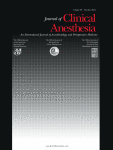Slightly off topic but anyone notice a clinically significant difference in spinal duration with epi wash vs. 100 mcg dose of epi?
In this single center, prospective, double-blind, randomized control trial, the addition of epinephrine 200 µg to hyperbaric bupivacaine and preservative-free morphine for repeat cesarean delivery prolonged the duration of the sensory blockade. Motor blockade was similarly prolonged and block...

pubmed.ncbi.nlm.nih.gov
The short version is they found a statistically significant difference with 200 mcg epi but not with 100 mcg.
The Effect of Adding Subarachnoid Epinephrine to Hyperbaric Bupivacaine and Morphine for Repeat Cesarean Delivery: A Double-Blind Prospective Randomized Control Trial
Background: Spinal anesthesia has become the most common type of anesthetic for cesarean delivery. The major limitation to spinal anesthesia is that the duration of the anesthetic may not be adequate in the event of a prolonged surgery. Some practitioners add epinephrine to hyperbaric bupivacaine to increase the duration, although its effect has not been fully studied. We therefore aimed to evaluate whether adding epinephrine to the spinal medication prolongs the duration of action of the resultant block in women presenting for repeat cesarean delivery.
Methods: Sixty-eight patients were randomized to receive no epinephrine (NE group), epinephrine 100 µg (low-dose [LD] group), or epinephrine 200 µg (high-dose [HD] group) with a standardized spinal mixture (1.5 mL 0.75% hyperbaric bupivacaine with 0.25 mg morphine). Sixty-five patients were included for primary analysis. Our primary outcome was time to intraoperative activation of the epidural catheter or postoperative regression of sensory blockade to T-10 dermatome level as measured by pinprick sensation; motor recovery was a secondary outcome, and graded via a Modified Bromage scale.
Results: Block onset time, vital sign changes, and the incidence of hypotension; nausea, and vomiting were similar among groups. Median difference in time to T-10 regression was greatest in the HD group compared to the NE group (median difference [min] [95% confidence interval]: 40 [15-60]; P = .007), followed by the HD group to the LD group (30 [15-45]; P = .007). Comparisons of LD to NE were not significant, but trended to an increase in T-10 regression time (10 [-15 to 30]; P = .76). Median difference in time to knee extension (Bromage 3) was also greatest in the HD group when compared to both the LD and NE group (median difference [min] [95% confidence interval]: 30 [0-60]; P = .034, 60 [0-93]; P = .007). Median difference time to knee extension (min) between the LD and NE group was also significant (37.5 [15-60]; P = .001]. Pain scores during the procedure were higher in the NE group (median [interquartile range] HD: 0 [0-0], LD: 0 [0-0], NE: 0 [0-3]; P = .02) during uterine closure and were otherwise not significantly different from the other groups.
Conclusions: In this single center, prospective, double-blind, randomized control trial, the addition of epinephrine 200 µg to hyperbaric bupivacaine and preservative-free morphine for repeat cesarean delivery prolonged the duration of the sensory blockade. Motor blockade was similarly prolonged and block quality may have been enhanced.

